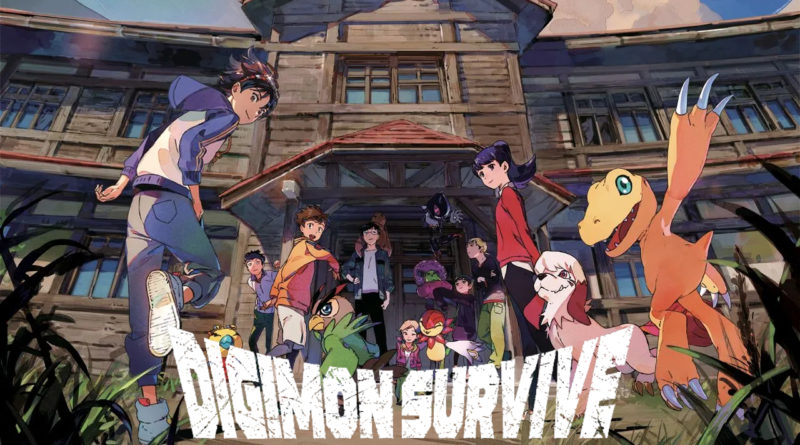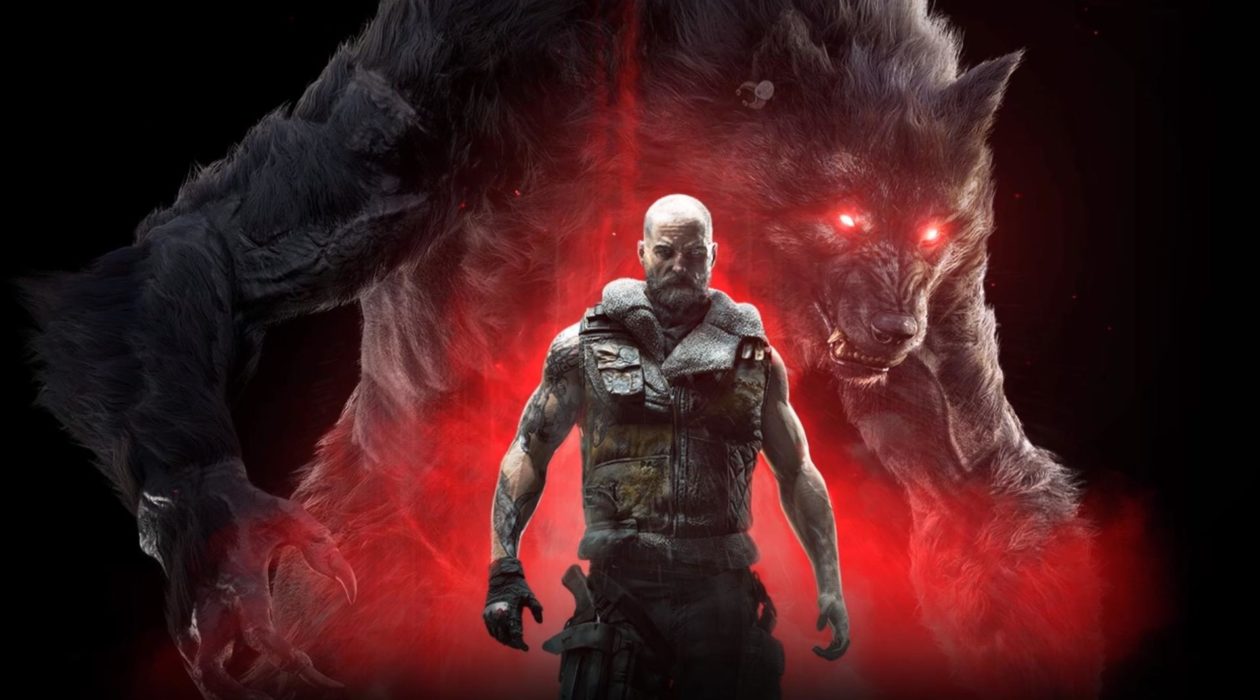Digimon Survive Review (PS4) – Digi-do or Die
Will the long-delayed Visual Novel/Tactics RPG hybrid Digimon Survive spirit you away, or is it digi-destined to fail? The Finger Guns Review:
After numerous delays from its initial 2019 release date and even a development studio change, Digimon Survive is finally here. A blend of visual novel and tactical RPG, Survive aims to tell a darker tale of children and their monster partners struggling to cope with being brought into an unfamiliar and dangerous new world. Twenty-four hours of playtime later, did it manage to blend the two genres effectively, as well as tell a captivating story? Read on to find out.
It’s worth upfront mentioning that the visual novel elements are the bulk of Digimon Survive’s content. I spent about 3/4s of my playtime on dialogue scenes and some very light exploration elements. Survive tells its story through text and Japanese voice acting. As a non-japanese speaker, however, it is a lot of reading. I knew about this going in, so it’s not a negative against the game for me. But I think it’s worth pointing out for the sake of the review. If you’re looking for something combat-heavy, or if the Survive part of its name gives you the impression it’s a survival game along the lines of Rust with Digimon, this isn’t the game for you.
A Monster-Sized Story
The story Digimon Survive tells is quite good, and it always kept me pushing through to see the game through to one of its multiple endings. Simply put, a group of camping kids find themselves pulled from their world and thrown into the world of the Digimon. The cast is full of the expected character types like the bubbly airhead, the headstrong older brother, or the confident leader. Each character quickly finds themself paired with a Digimon partner that mirrors their personality. They each bond throughout the story with their partners and the rest of the group.
Underneath these cliched archetypes, however, Digimon Survive ekes out some subtleties that give you a deeper look into who these kids are. It’s also worth remembering that the cast is just that: they’re kids. They range from 11-16 years old, and Digimon Survive isn’t afraid to show the effects their sudden appearance in this dangerous world has on them. There are moments early on that touch on some genuinely mature subject matter, so much so that I’m genuinely surprised it landed a PEGI 12 rating.
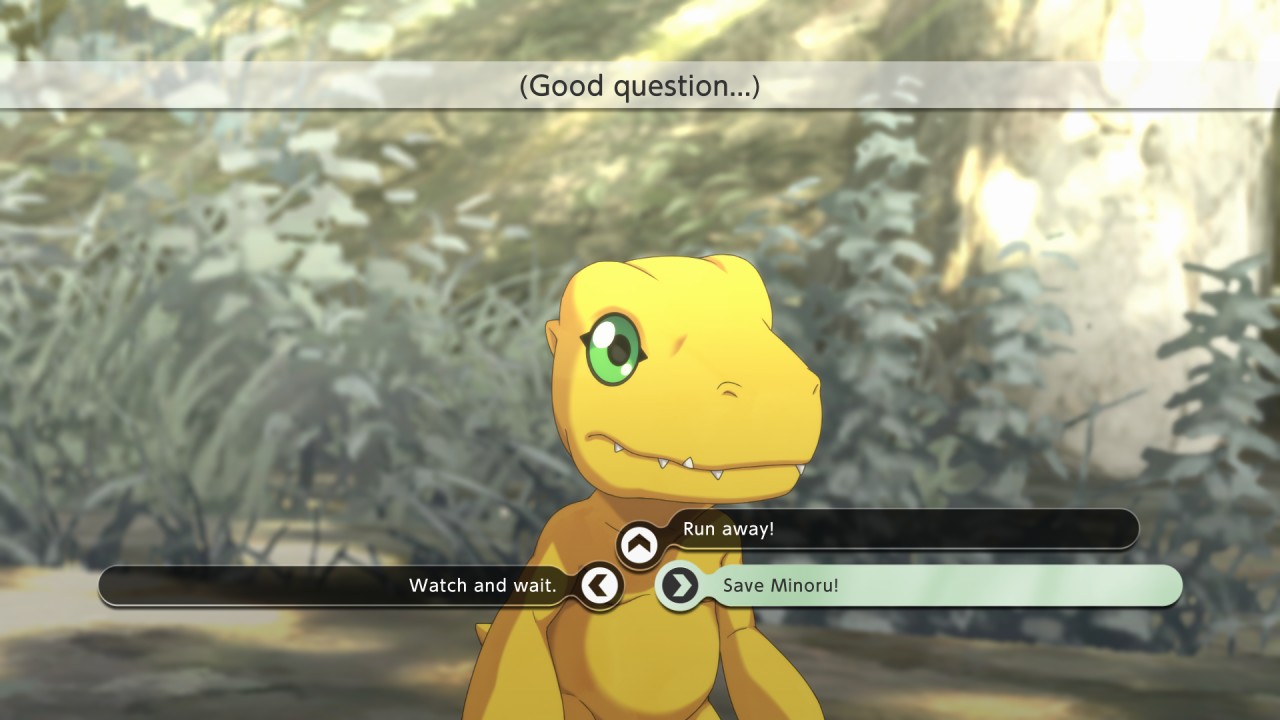
Choices That Matter
Throughout the story, Digimon Survive gives you multiple choices, some of which are just for flavour, but the bulk of them have an active effect on the game’s Karma System. You have three alignments: Moral, Wrathful, and Harmony. Depending on your choices, the story will eventually branch into one of 3 routes. It’s not just the story that is affected, however. Your main character’s partner Digimon, Agumon, will evolve differently based on whichever alignment is highest. It’s a neat little mechanic and adds to the game’s overall replay value. The game’s UI lets you know which alignment type each choice represents by subtly glowing the associated colour. It also helps that each alignment is always in the same position: left is Moral, up is Wrathful, and right is Harmony. You can always check your current Karma levels in the games Profile menu to see which path you’re on so you can course correct if you want to.
The biggest issue I found with Digimon Survive’s story was that it would constantly play its hand too early. The darkest and most captivating plot points happen in its first half, leaving the second a little flat in comparison. It was never a bad story, however. It was always enjoyable, but it never reached the same highs of its first half. Things that the game treats as big reveals ended up obvious more often than not, with a few major reveals/twists taking too long in delivering their payoff. It’s a problem I’ve noticed with mystery elements in the genre that isn’t exclusive to Digimon Survive. I feel there was, more often than not, too much time spent dancing around the reveal instead of pushing the story forward. It’s unsatisfying waiting for maybe hours for the characters to come to the same realisation that you have. I also noticed a few instances of characters talking about the wrong character, and there are some questionable dialogue choices. I don’t think any 15-year-old in 2020 is saying “word” or “sup, party people”. It gives the vibe of a much older person trying to be “down with the kids”, but thankfully it only happened a handful of times.
Digimon Survive also lets you explore its areas at multiple points in the story. The game gives you a list of locations to visit, with each having characters to speak to or spots to investigate. These conversations give little snippets of backstory and sometimes a chance to increase your affinity with the other characters. The areas you can examine will sometimes give you items, flavour text, or potentially contain an optional enemy encounter.
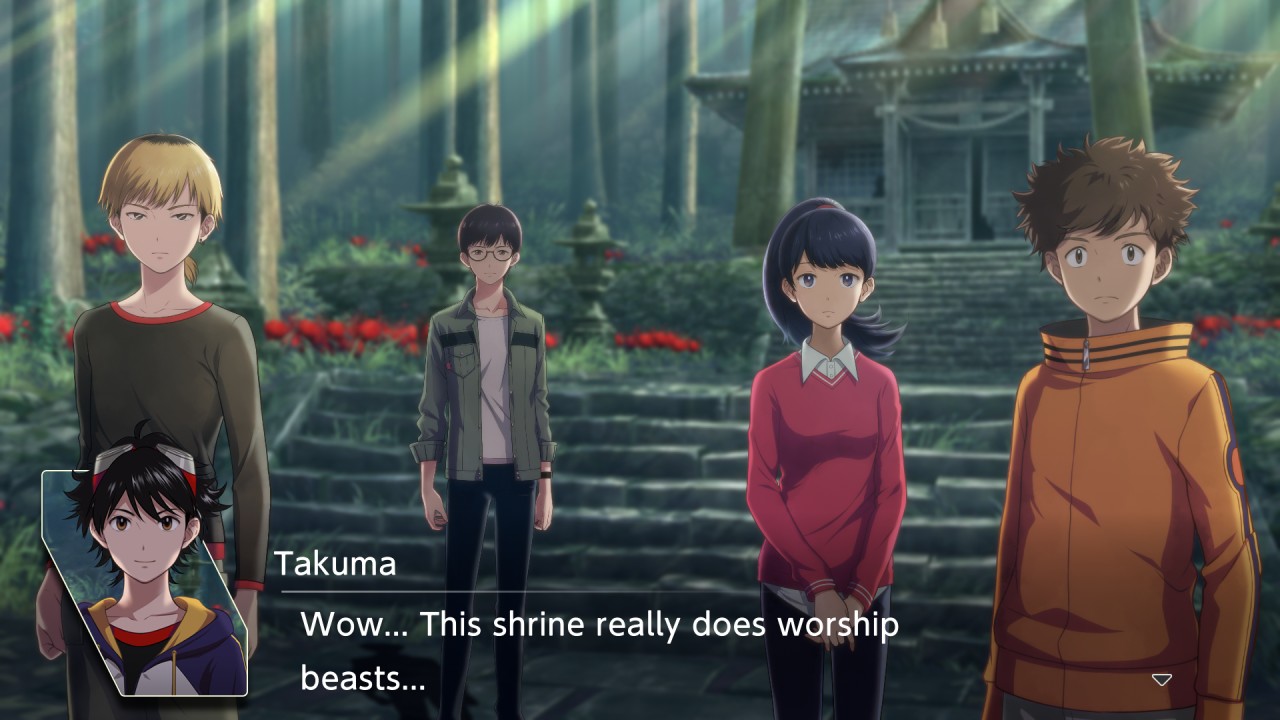
You Got Some Tactical Combat in my Visual Novel
If 3/4 of Digimon Survives runtime is the visual novel element, then naturally, that final 1/4 must belong to the tactical RPG chunk of the gameplay. It’s the traditional TRPG setup: turn-based, isometric, grid-based combat. At the start of every battle, the game lets you pick as many Digimon as that battle allows. Sometimes there will be Digimon that are either mandatory or unavailable, but it’s all story dependent. The game determines turn order based on the speed stat of each Digimon, and you can always see who’s going next at the side of the screen. It’s always appreciated when this information is given to you, as it lets you plan your moves around the enemy’s strengths and weaknesses.
As the story progresses, your party’s main Digimon will get the ability to evolve into multiple forms. These forms cost SP (the game’s resource for special attacks) to maintain each turn, with each progressive evolution costing more. These costs never actually forced me to play differently, however. The power increase of evolving always outweighed the SP cost, and I was forced to de-evolve before I’d finished the fight.
During Free Battles, you’ll have the opportunity to have wild Digimon join your roster. You do this through a conversation similar to that of the Shin Megami Tensai franchise. Each Digimon has a personality type and will ask you three questions. Your answers will either fill or empty a gauge based on whether or not the monster likes your response. If you’ve filled it at least halfway, you’ll be able to ask for an item or to have the Digimon come with you. You’ll see the percentage chance of convincing them to join you based on your karma alignment levels. Each Digimon has a type associated with each of the three alignments: Moral is Vaccine type, Wrathful is Virus type, and Harmony is Data type. The higher your associated alignment is, the higher your chance of that type of Digimon joining you. These types also add a rock-paper-scissors element to combat, each having a strength and weakness, which amounts to an increase or decrease in damage, respectfully. There are also elemental resistances to deal with alongside the types.
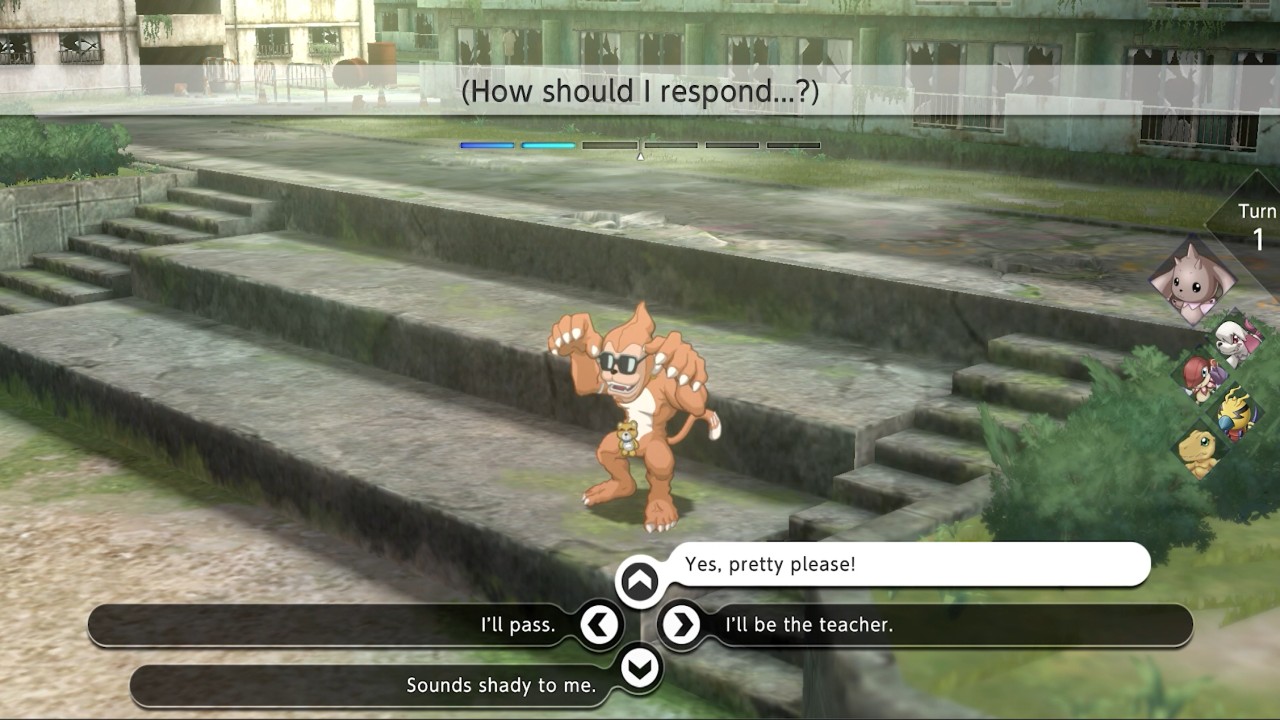
Digimon Survives combat is, however, its weakest element. It never has enough strategic depth to keep it engaging. It’s laughably easy on the default difficulty, and turning it up just seemed to alter the amount of damage you deal and receive. All that means is more time spent grinding to increase your levels and stats. It’s never a satisfying way to increase difficulty; it only serves to waste your time. Levelling your Digimon never teaches them anything new, either. Evolving your main Digimon is tied to the story, and your other Digimon need an item to do so, and it’s irreversible for them. Old moves don’t carry on through your evolutions, either, with one exception. Each Digimon has two equipment slots to give them various stat increases or to let them use a new move. It makes levelling up somewhat unrewarding, as you don’t get any exciting tools to use in battle, just a higher number for your stats. There’s also a system where you can have the human characters shout encouragements at your Digimon to give them a temporary buff, depending on who’s doing the shouting. I never found this feature necessary, as battles were easy enough without it.
Thankfully, the game gives plenty of options to render battles essentially skippable. At the start of each fight, you can set your difficulty. It defaults to Normal, with Very Easy, Easy, and Hard as your other options. Once you’ve set it to something else, the game will default any further battles to that until you change difficulties again. I got to chapter 8 playing on Normal, but when it became clear the combat wasn’t going to be doing anything new or exciting, I dropped it to very easy and set each fight to auto-battle. I was so uninterested in each encounter by that point that I’d honestly have preferred there be an option to skip them entirely. It actively made me enjoy the game less by its end. It was never bad enough that I wanted to give up; I wanted to see this story through, but if those difficulty and auto-battle settings didn’t exist, I might have.
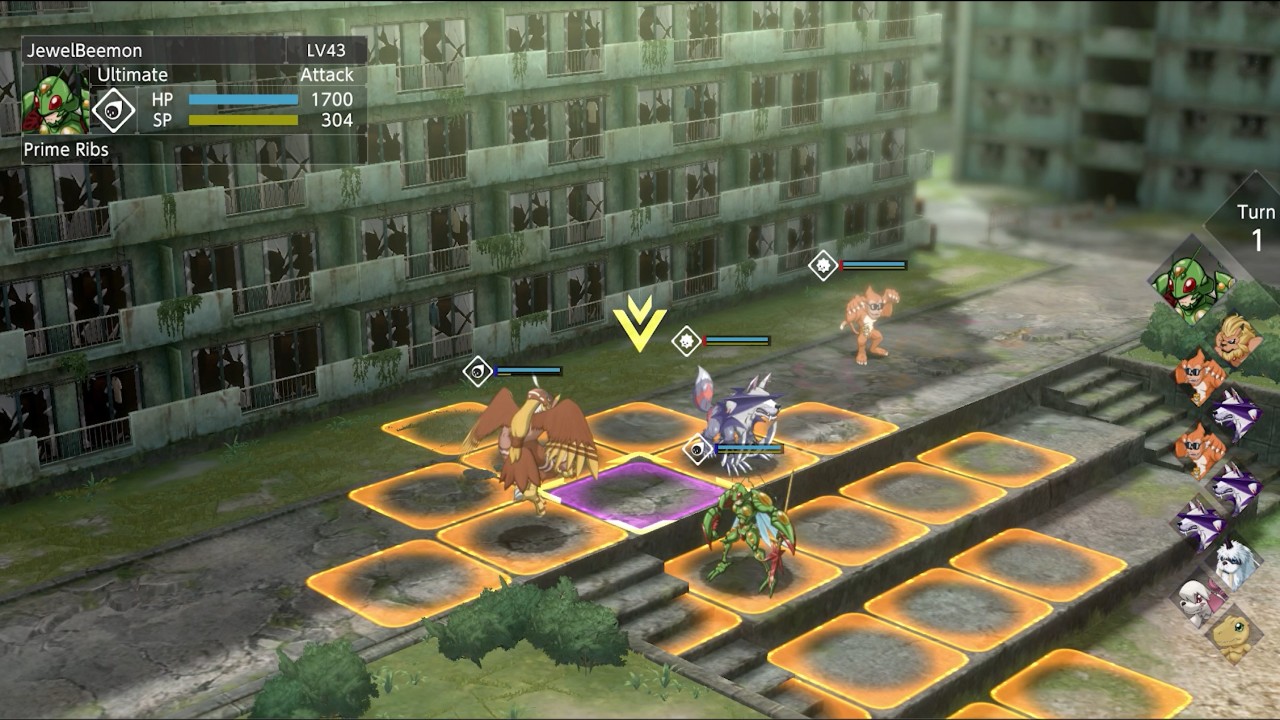
Plenty for fans to come back for
The biggest issue in Digimon Survive for me is its combat, but its presentation is excellent. Instead of static characters and environments that visual novels often present you with, Digimon Survive adds some little touches that give it a more premium polish. Characters have lip flaps during dialogue, a range of expressions based on the situation, and their hair moves naturally during animations. The environments appear to be 3D scenes populated with hand-drawn, 2D objects. They look like little dioramas or pop-up books. This polish extends to the combat, and while there’s not a massive variety in the map types you’ll be fighting in, the Digimon are all very nicely animated. I’m not typically a fan of the style of animation Digimon Survive uses, but it works well for this type of game. Each body part is a separate 2D element, and they’re joined together like a skeleton to animate, much like you would a 3d character. It’s great to look at from start to finish. There’s even a short animated intro and opening credits sequence which are great, and I’d have loved to have seen more of this, but Digimon Survive isn’t a full-priced release, so I get why it’s limited.
There’s also a solid amount of replay value to the game, especially given it’s already >20 hours long. Upon beating it, Digimon Survive gives you the option to start new game+ run and a hint that there may be some changes. There’s also a point in the story where the game tells you that you’ve hit the branching point in the narrative and lets you create a save file to reload if you want to try the other routes. If you end up loving the game, there’s more here for you, but I can’t see myself replaying it to see the content I missed.
Digimon Survive is a solid blend of Visual Novel and Tactics RPG. It has great moments, but Survive’s combat encounters lack any real depth or challenge to keep them engaging over its runtime. Its story, however, remains interesting enough to push it along, even if it hits its peaks early on. A little more variety could’ve pushed Digimon Survive from good to great.

Digimon Survive is available now on PlayStation 4 (reviewed), Xbox One, Nintendo Switch and PC.
Developer: Hyde
Publisher: Bandai-Namco
Disclaimer: In order to complete this review, we were provided with a promotional copy of the game. For our full review policy, please go here.
If you enjoyed this article or any more of our content, please consider our Patreon.
Make sure to follow Finger Guns on our social channels –Twitter, Facebook, Twitch, Spotify or Apple Podcasts – to keep up to date on our news, reviews and features.
